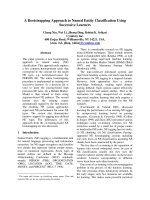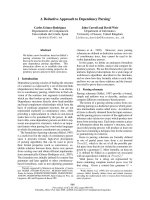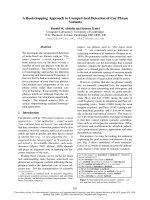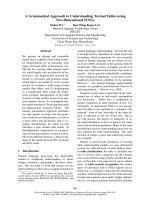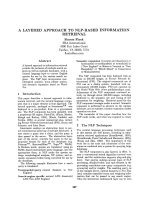Báo cáo khoa học: "A Corpus-Centered Approach to Spoken Language Translation" pptx
Bạn đang xem bản rút gọn của tài liệu. Xem và tải ngay bản đầy đủ của tài liệu tại đây (239.59 KB, 4 trang )
A Corpus-Centered Approach to Spoken Language Translation
Eiichiro SUMITA, Yasuhiro AKIBA, Takao DO!, Andrew FINCH, Kenji IMAMURA,
Michael PAUL, Mitsuo SHIMOHATA, and Taro WATANABE
ATR Spoken Language Translation Research Laboratories
2-2-2 Hikaridai, Keihanna Science City, Kyoto 619-0288, JAPAN
e iichiro. sumitagatr. co
jp
Abstract
This
paper reports the latest performance of com-
ponents and features of a project named
Corpus-
Centered Computation (C'
3
),
which targets a trans-
lation technology suitable for spoken language
translation.
C
3
places
corpora
at the center of the
technology. Translation knowledge is
extracted
from corpora
by both EBMT and SMT methods,
translation quality is
gauged by referring to cor-
pora,
the best translation among multiple-engine
outputs is
selected based on corpora and the
cor-
pora themselves are paraphrased or filtered
by
automated processes.
1 Introduction
Our project, named
Corpus-Centered Computation
((
3
),
proposes solutions for efficiently constructing
a high-quality translation subsystem for a speech-
to-speech translation system.
This paper introduces recent progress in
C
3
.
Sec-
tions 2 and 3 demonstrate a competition between
multiple machine translation systems developed in
our project, and Sections 4 and 5 explain the fea-
tures that differentiate our project from other cor-
pus-based projects.
2 Three Corpus-based MT Systems
There are two main strategies in corpus-based ma-
chine translation: (i) Example-Based Machine
Translation (EBMT; Nagao, 1984; Somers, 1999)
and (ii) Statistical Machine Translation (SMT;
Brown et al., 1993; Knight, 1997; Ney, 2001; Al-
shawi et al., 2000).
C
3
is developing both tech-
nologies in parallel and blending them. In this
paper, we introduce
three
different machine trans-
lation systems: Di,
HPAT, and
SAT.
The three MT systems are characterized by dif-
ferent translation units.
D
3
, HPAT,
and
SAT
use
sentences, phrases, and words, respectively.
D
3
(Sentence-based EBMT): It retrieves the most
similar example by DP-matching of the input and
example
sentences
and adjusts the gap between the
input and the retrieved example by using dictionar-
ies. (Sumita 2001)
HPAT
(Phrase-based EBMT): Based on
phrase-
aligned bilingual trees, transfer patterns are gener-
ated. According to the patterns, the source phrase
structure is obtained and converted to generate tar-
get sentences (Imamura 2002)
SAT
(Word-based SMT): Watanabe et al.
(2002b) implemented
SAT
dealing with Japanese
and English on top of a word-based SMT frame-
work (Brown et al. 1993).
3 Competition on the Same Corpus
3.1 Resources
In our competitive evaluation of the MT systems,
we used the BTEC corpus ', which is a collection
of Japanese sentences and their English transla-
tions typically found in phrasebooks for tourists.
The size is about 150 thousand sentence pairs. A
quality evaluation was done using a test set
consisting of 345 sentences selected randomly
from the above corpus, and the remaining
sentences were used for learning and verification.
For each source sentence in the test set, 16
reference translations were prepared by 5 bilingual
translators.
1
BTEC was called BE in the paper (Takezawa et al.,
2002).
171
We used bilingual dictionaries and thesauri of
about fifty thousand words for the travel domain.
3.2 Evaluation Measures
We used the
measures below. The BLEU score
and the RED rank are measured by referring to the
test corpus, i.e., a set of input sentences and their
multiple reference translations; the HUMAN rank
and the estimated TOEIC score are judged by bi-
lingual translators.
(1)
Average of Ranks
2
:
HUMAN rank: In our evaluation, 9 translators
who are native speakers of the target language
ranked the MT translations into 4 ranks: A, B, C,
and D, from
good to
bad
(Sumita et al., 1999).
3
RED rank: An automatic ranker is learned as a
decision tree from HUMAN-ranked examples. It
exploits edit-distances between MT and multiple
reference translations (Akiba et al., 2001).
(2)
BLEU score: The MT translations are scored
based on the precision of N-grams in an entire set
of multiple reference translations (Papineni et al.,
2002). It ranges from 1.0 (best) down to 0.0
(worst).
(3) Estimated TOEIC score: It is important to
interpret MT performance from the viewpoint of a
language proficiency test such as TOEIC
4
. A trans-
lator compared MT translations with human ones,
then, MT's proficiency is estimated by regression
analysis (Sugaya et al., 2000). It ranges from 10
(lowest)
to 990 points
(perfect).
3.3 Results
Table 1 wraps up the results. So far, SMT has been
applied mainly to language pairs of similar Euro-
pean languages. Skeptical opinions dominate about
2
Average is calculated: A, B, C, and D are assigned
values of 4, 3, 2, and 1, respectively, and their sum is
divided by the sentence count (345 in the experiment).
3
The final rank for each translation is the
median
of the
nine ranks given by independent evaluators.
4
TOEIC is an acronym for 'Test of English for
International Communication', which is an
English
language proficiency test for people whose native
language is not English ( />the effectiveness or applicability of SMT to dis-
similar language pairs. However, we implemented
SMT for translation between Japanese and English.
They are dissimilar in many points, such as word
order and lexical systems. We found that
SAT,
which is an SMT, worked in both J-to-E and E-
to-J directions.
The EBMT systems,
HPAT
and
D
3
,
surpassed
SAT
in the HUMAN rank. This is the reverse re-
sult obtained in a Verbmobil experiment (Ney,
2001) where an SMT system scored highest. We
are studying these interesting contradictory
observations.
Let's consider the relationships among the
HUMAN rank, the RED rank, and the BLEU score.
While RED accords with HUMAN, BLEU fails
to agree with HUMAN in the EJ evaluation.
One reason for this is that the BLEU score favors
SAT
translations in that they are more similar to the
reference translation from the viewpoint of N-
grams.
Table 1 Quality Evaluation of Three MTs
5
pair
MT
JE
SAT
HPAT
EJ
SAT
Average of
HUMAN
3.21
2.66
3.17
2.89
Average of
RED
3.44
2.61
3.13
2.91
BLEU
0.49
0.43
0.48
0.56
Let's move on to the estimated TOEIC score of
the most accurate JE system in the experiment.
D
3
achieved a high score of 870. This is more than
one hundred points higher than the average score
of a Japanese businessperson in an overseas de-
partment of a company.
4
Corpus-based Selector
This section introduces a feature of
C
3
: selection
of
the best from outputs produced by multiple transla-
tion engines.
No single system can achieve complete transla-
tion of every input. The quality rank of a given
input sentence changes system by system. We
show a sample of different English translations
5
HPAT
for JE and
D
3
for EJ also work well, but we
omitted them from the table because we could not
afford the time and cost of the human evaluation for
them.
172
obtained by the three systems for the Japanese sen-
tence, 'o-shiharai wa genkin desu ka kurejitto
kaado desu ka'
(Table 2).
The brackets show the
HUMAN rank, as described above.
Table 2. Sample of Translation Variety
[B]
Is the payment cash? Or is it the credit card?
[A] Would you like to pay in cash or with a credit card?
[C]
Could you cash or credit card?
In our experiment, while
D
3
, HPAT,
and
SAT
for
the E-to-J direction have A-ratios of 0.62, 0.55,
and 0.53, respectively, the ideal selection would
have an interestingly high A-ratio of 0.79. Thus,
we could obtain a large increase in accuracy if it
were possible to select the best one of the three
different translations for each input sentence.
Unlike other approaches such as (Brown and
Frederking, 1995), we do not
merge
multiple re-
sults into a single one but we
select
the best one
because the large difference between multiple
translations for distant language pairs such as Japa-
nese and English makes merging infeasible.
Methods using N-gram statistics of a target lan-
guage corpus have been proposed before (Brown
and Frederking, 1995; Callison-Burch et al., 2001).
They are based on the assumptions that (1) the
naturalness of the translations is effective for se-
lecting good translations because they are sensitive
to the broken target sentences due to errors in
translation processes, and (2) the source and target
correspondences from the semantic point of view
are maintained in a state-of-the-art translation sys-
tem. However, the second assumption does not
necessarily hold. To solve this problem, Akiba et al.
(2002) used not only a language model but also a
translation model of SMT derived from a corpus,
and Sumita et al. (2002) exploited a corpus whose
sentences are converted into semantic class se-
quences. These two selectors outperformed
con-
ventional selectors using the target N-gram
in our
experiments.
5 Paraphrasing and Filtering
This section introduces another feature of
C
3
:
paraphrasing
and
filtering corpora.
The large variety of possible translations in a
corpus causes difficulty in building machine trans-
lation on the corpus. For example, the variety
makes it harder to estimate the parameters for
SAT,
to find appropriate translation examples for
D
3
,
to
extract good transfer patterns for
HPAT.
We pro-
pose ways to overcome these problems by
para-
phrasing corpora
through automated processes or
filtering corpora
by abandoning inappropriate ex-
pressions.
Two methods have been investigated for auto-
matic paraphrasing. (1) Shimohata et al. (2002a)
group sentences by the equivalence of the transla-
tion and extract rules of paraphrasing by DP-
matching. (2) Finch et al. (2002) cluster sentences
in a handcrafted paraphrase corpus (Sugaya et al.,
2002) to obtain pairs that are similar to each other
for training SMT models, then by using the models
the decoder generates a paraphrase. The experi-
mental results indicate that (i) the EBMT based on
normalization had increased coverage (Shimohata
et al., 2002b) and (ii) the SMT created on the nor-
malized sentences had a reduced word-error-rate
(Watanabe et al., 2002a).
Imamura et al. (2003) proposed a calculation
that measures the literalness of a translation pair
and called it TCR. After the word alignment of a
translation pair, TCR is calculated as the rate of the
aligned word count over the count of words in the
translation pair. After abandoning the non-literal
parts of the corpus, the acquisition of
HPAT
trans-
fer patterns is done. The effect has been confirmed
by an improvement in translation quality.
6 Conclusion
Our project, called
C
3
,
places
corpora
at the center
of speech-to-speech technology. Good perform-
ance in translation components is demonstrated in
the experiment. In addition, the corpus-based proc-
esses of translation, evaluation, and paraphrasing
have synergistic effects. Therefore, we are optimis-
tic about the further progress of components and
their integration.
Acknowledgements
The research reported here was supported in part
by a contract with the Telecommunications
Advancement Organization of Japan entitled, "A
study of speech dialogue translation technology
based on a large corpus."
References
173
Alshawi, H., Bangalore, S. and Douglas, S. 2000.
Learning Dependency Translation Models as
Collections of Finite-State Head Transducers,
Computational Linguistics, 26 (1), pp. 45 60.
Akiba, Y, Imamura, K., and Sumita, E., 2001. Us-
ing multiple edit distances to automatically rank
machine translation output. In
Proc. of MTSum-
mit VIII,
pages 15-20.
Akiba, Y., Watanabe, T., and Sumita, E. 2002.
"Using Language and Translation Models to Se-
lect the Best among Outputs from Multiple MT
Systems, Proc. of Coling, pp. 8-14.
Brown, P., Cocke, J., Della Pietra, S. A., Della
Pietra, V. J., Jelinek, F., Laffetry, J. D., Mercer,
R. L., and Roossin, P. S., 1993. A Statistical
Approach to Machine Translation, Computa-
tional Linguistics 16, pp. 79-85.
Brown, R. and Frederking, R., 1995. Applying Sta-
tistical English Language Modeling to Symbolic
Machine Translation. In Proc. of the 6
th
TMI, pp.
221-239.
Callison-Burch, C. and Flournoy, S., 2001. A Pro-
gram for Automatically Selecting the Best Out-
put from Multiple Machine Translation Engines,
Proc. of MT-SUMMIT.
Finch, A, Watanabe, T., and Sumita, E., Paraphras-
ing by Statistical Machine Translation, 2002,
Proc. of FIT, E-53, pp.187 188.
Imamura, K., 2002. Application of Translation
Knowledge Acquired by Hierarchical Phrase
Alignment, Proc. of TMI.
Imamura, K., Sumita, E. and Matsumoto, Y., 2003.
Automatic Construction of Machine Translation
Knowledge Using Translation Literality, Proc.
of EACL.
Knight, K., 1997. Automating Knowledge Acquisi-
tion for Machine Translation, Al Magazine, 18
(4), pp. 81 96
Nagao, M., 1984. A Framework of a Mechanical
Translation between Japanese and English by
Analogy Principle, in A. Elithorn and R. Banerji
(eds), Artificial and Human Intelligence, Am-
sterdam: North-Holland, pp. 173 180.
Ney, H., 2001. Stochastic Modeling: From pattern
classification to language translation, in Proc. of
the ACL 2001 Workshop on DDMT, pp. 33 37.
Papineni, K., Roukos, S., Ward, T., and Zhu, W.
J., 2002. Bleu: A Method for Automatic Evalua-
tion of Machine Translation, Proc. of the 40
6
ACL, pp. 311 318.
Shimohata, M. and Sumita, E., 2002a. Automatic
paraphrasing based on parallel corpus for nor-
malization, Proc. of LREC.
Shimohata, M. and Sumita, E., 2002b. "Identifying
Synonymous Expressions from a Bilingual Cor-
pus for Example-Based Machine Translation,"
Proc. of the Workshop on Machine Translation
in Asia, Coling, pp. 20 25.
Somers, H., 1999. Review Article: Example-based
Machine Translation, Journal of Machine
Translation, pp. 113-157.
Sugaya, F., Takezawa, T., Yokoo, A., Sagisaka, Y.,
and Yamamoto, S., 2000. Evaluation of the
ATR-MATRIX Speech Translation System with
a Pair Comparison Method Between the System
and Humans, Proc. of ICSLP, pp. 1105-1108.
Sugaya, F., Takezawa, T., Kikui, G. and Yama-
moto, S., 2002. Proposal of a very-large-corpus
acquisition method by cell-formed registration,
Proceedings of the LREC.
Sumita, E., 2001. Example-based machine transla-
tion using DP-matching between word se-
quences, Proc. of ACL 2001 Workshop on
DDMT, pp. 1 8.
Sumita, E., Akiba, Y., and Imamura, K., 2002.
"Reliability Measures For Translation Quality,"
ICSLP, pp. 1893-1896.
Sumita, E., Yamada, S., Yamamoto, K., Paul, M.,
Kashioka, H., Ishikawa, K., and Shirai, S., 1999.
Solutions to Problems Inherent in Spoken-
language Translation: The ATR-MATRIX Ap-
proach, Proc. of MT Summit, pp. 229-235.
Takezawa, T. et al., 2002. Toward a Broad-
coverage Bilingual Corpus for Speech Transla-
tion of Travel Conversations in the Real World,
Proc. of LREC.
Watanabe, T. et al., 2002a. Statistical Machine
Translation Based on Paraphrased Corpora, Proc.
of LREC.
Watanabe, T. et al., 2002b. "Bidirectional Decod-
ing for Statistical Machine Translation," Proc. of
Coling, pp. 1079-1085.
174
